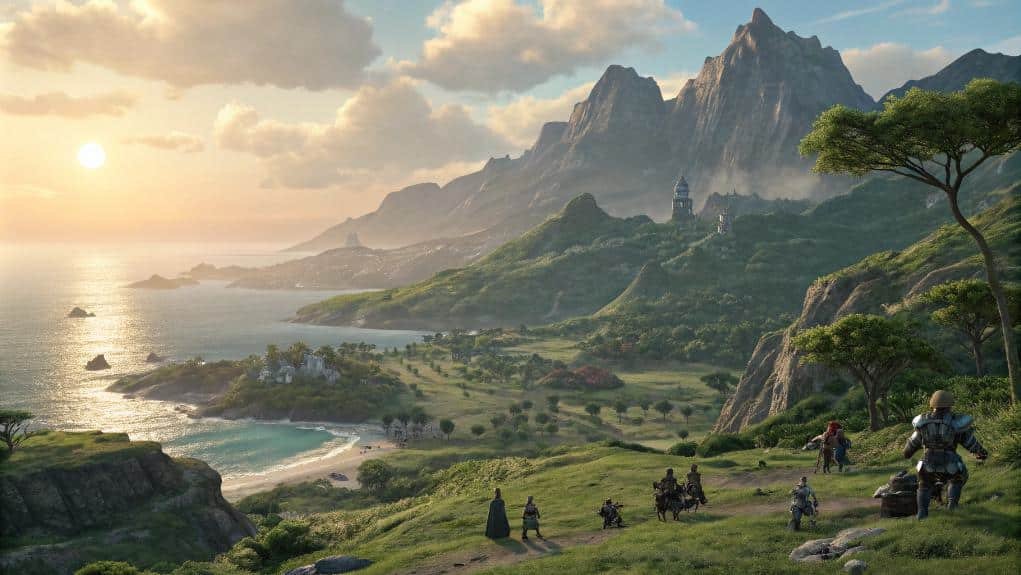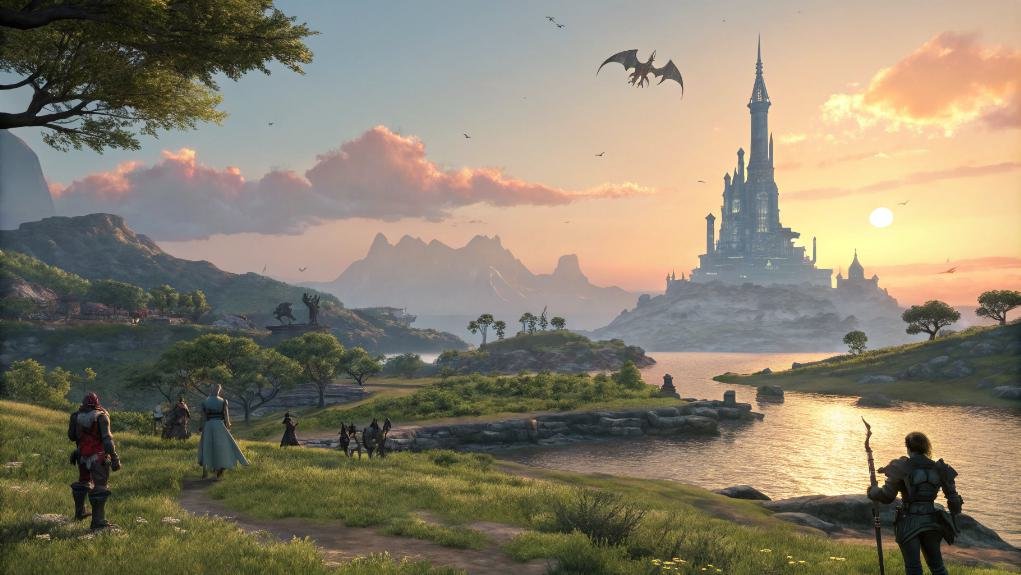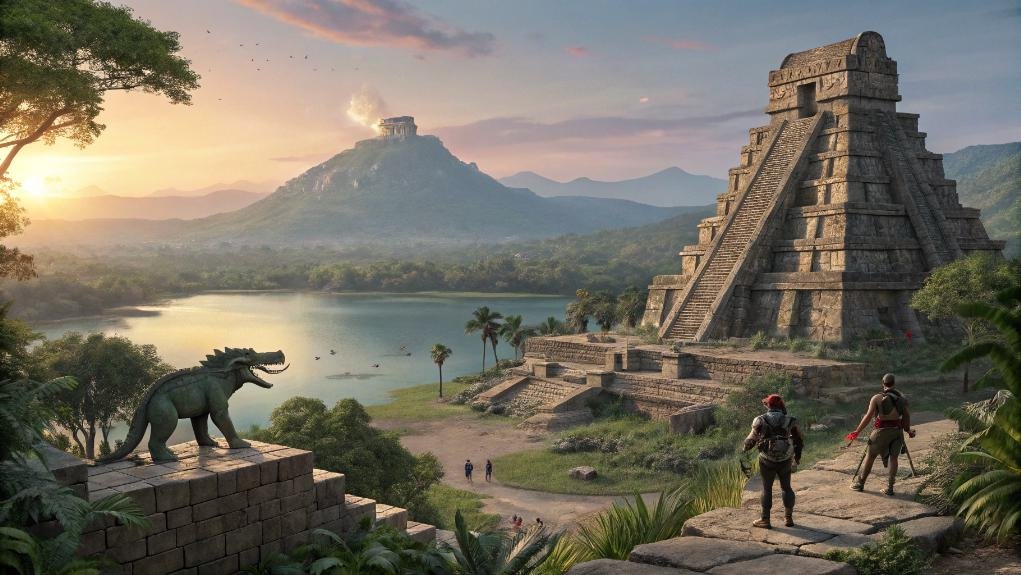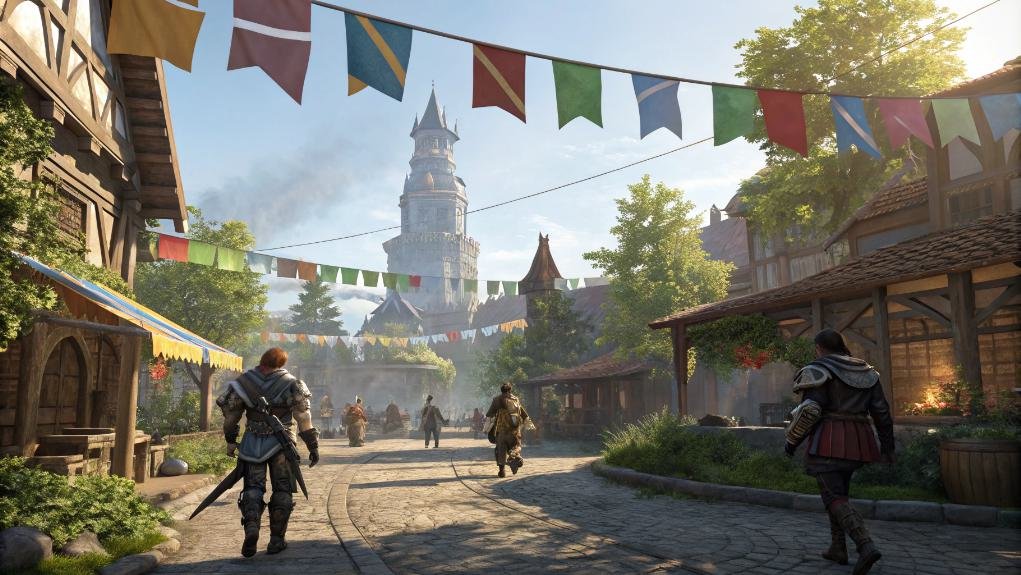Final Fantasy XIV's history reflects a fascinating narrative of redemption and evolution. Following its troubled launch in 2010, which was marred by gameplay flaws and community backlash, Naoki Yoshida's leadership initiated a complete overhaul. The game re-emerged as A New World Reborn in 2013, earning critical acclaim. This revival led to immersive expansions like Heavensward and Shadowbringers, each enriching Eorzea's cultural tapestry and gameplay mechanics. Significant events such as the Seventh Umbral Calamity transformed both the landscape and societal dynamics within the game. Understanding these layers reveals much about player engagement and community development, inviting further exploration of its enchanting world.
Key Takeaways
- Final Fantasy XIV was initially launched in 2010 but faced significant criticism for poor gameplay, leading to its redevelopment.
- Naoki Yoshida's leadership transformed the game, resulting in the successful relaunch as A Realm Reborn in 2013.
- Major events, like the Seventh Umbral Calamity, significantly reshaped Eorzea's landscape and lore, influencing gameplay and community dynamics.
- The game has evolved through major expansions, introducing new jobs, mechanics, and gameplay features, enhancing player experience over time.
- Upcoming expansion Dawntrail is set for Summer 2024, promising new jobs, visual upgrades, and a new playable race.
Background and Initial Storyline

In the early 2000s, the ambitious development of Final Fantasy XIV marked a significant evolution in the domain of MMORPGs, setting the stage for an expansive narrative within the fantasy world of Eorzea. Players step into the shoes of a customized Adventurer avatar, with the choice of five playable races, each featuring two tribes and options for male or female characters.
This character customization includes detailed alterations such as eye color, hair style, and skin tone, allowing for unique avatar creation. The chosen race and its associated patron deity significantly influence the character's stats and elemental attributes, integrating lore into gameplay.
Initial quests immerse players in Eorzea's rich history, where they awaken to the Echo power, granting them visions of the past—crucial for understanding the complex faction dynamics at play. The three main powers—Gridania, Ul'dah Sultanate, and Limsa Lominsa—each offer distinct cultural backdrops that enhance the player's experience. The main setting is Eorzea, a geopolitical region on planet Hydaelyn, divided into these three powers and other notable locations.
This intricate lore integration guarantees that players not only engage with the mechanics but also with the narrative threads that bind the world together, setting a profound foundation for their journey.
The Seventh Umbral Calamity
The escape of Bahamut during the Seventh Umbral Calamity released unprecedented chaos across Eorzea, marking a significant turning point in its history. As fragments of the fallen Dalamud rained down, the domain faced widespread destruction, prompting urgent rebuilding efforts that would shape its future. This calamity not only altered the landscape but also ignited a renewed determination among its inhabitants to recover and redefine their world. The emergence of Bahamut, identified as a prison for the Elder Primal, further complicated the challenges Eorzea faced in the aftermath.
Bahamut's Escape Unleashed Chaos
Amidst the turbulent backdrop of Eorzea, Bahamut's escape from Dalamud released a cataclysm that would forever alter the domain's fate. This event, known as the Seventh Umbral Calamity, stemmed from a series of tragic influences and desperate actions.
Tiamat's sorrow and rage over losing Bahamut catalyzed his corruption, while Ascian manipulation drove her to summon him as a primal. The Allagan Empire's desperation further exacerbated the situation, as they recklessly harnessed Bahamut's power.
The catastrophic breakdown of the Binding Coil, designed to contain him, ultimately led to his release. The consequences were immediate and devastating:
- Widespread environmental destruction ravaged the land.
- Global chaos ensued as people fled in terror.
- Molten shards and flames indiscriminately torched everything.
- Memory fragments of the event left lasting confusion.
Bahamut's awakening marked a pivotal moment, as the world faced fiery destruction and a reckoning with the primal's overwhelming might. As the dust settled, the impact of this calamity reverberated through Eorzea, leaving scars that would take generations to heal. Additionally, the chaos prompted the emergence of flying mounts, allowing adventurers to explore previously unreachable areas in the aftermath of the calamity.
Aftermath and Rebuilding Efforts
Reeling from the devastation of the Seventh Umbral Calamity, the people of Eorzea faced the monumental task of rebuilding their shattered world. Survival strategies emerged as communities banded together, fostering societal transformations that emphasized cooperation among city-states.
The calamity catalyzed the formation of new alliances, uniting previously disparate factions against the ongoing threat of the Garlean Empire. The Ascians, former summoners of Zodiark, orchestrated calamities to weaken barriers between worlds, which underscored the importance of vigilance against future threats.
Adventurers who ventured into aetherial rifts, guided by Louisoix, became pivotal in mitigating the aetherial challenges that arose post-calamity. These efforts prompted significant magical reevaluations, as practitioners recognized the perils of overusing aether.
Historical reflections on past calamities served as important lessons, urging Eorzeans to advocate for sustainable magic.
The chaos spurred philosophical debates on the nature of power and responsibility, reshaping the discourse surrounding magic and its use. As Eorzea rebuilt, it not only sought to restore what was lost but also to forge a resilient society, learning valuable lessons in adaptability and unity.
The legacy of the Seventh Umbral Calamity would forever resonate, a reminder of the delicate balance between ambition and the potential for destruction.
The A Realm Reborn Era

The A Realm Reborn Era
Set against the backdrop of a shattered Eorzea, the A New Era Reborn phase marks a pivotal transformation in the game's narrative. Following Louisoix's sacrifice and the chaos of the Seventh Umbral Calamity, the Eorzean Alliances emerge, uniting city-states against the formidable Garlean Empire.
Adventurers, either new or those transported through the time rift, begin their journeys to restore peace.
Key developments during this era include:
- Scion Leadership: Minfilia and her team guide adventurers through escalating threats.
- Primal Conflicts: Players confront various primals, manipulated by the Ascians to sow discord.
- Garlean Strategies: The Garlean invasion looms large, with Gaius van Baelsar leading the charge.
- Ascian Manipulation: The influence of Lahabrea complicates the conflict, affecting allies like Thancred. Additionally, the Ascians' manipulative tactics are revealed to be part of a larger scheme to weaken Eorzea's defenses.
As the narrative unfolds, the adventurers participate in Operation Archon, a counteroffensive against the Garleans and their Ultima Weapon.
With Gaius's defeat and the purging of Lahabrea, the threat diminishes, heralding the dawn of the Seventh Astral Era and solidifying the adventurer's role as a hero in Eorzea's recovery.
Major Expansions Overview
In the evolution of Final Fantasy XIV, each major expansion introduces significant storyline developments and innovative gameplay features that enhance the player experience.
From the dragon-centric conflicts in Heavensward to the climactic battles against the Garlean Empire in Stormblood, the narrative continually draws players deeper into Eorzea's lore. The introduction of flying mechanics in Heavensward marked a significant shift in how players explored the world, adding a new layer of freedom to the experience.
Additionally, expansions like Shadowbringers and Endwalker expand gameplay mechanics, introducing new jobs and features such as underwater exploration and the Crystalline Conflict, which keep the gameplay fresh and engaging.
Key Storyline Developments
While the world of *Final Fantasy XIV* has undergone significant transformations since its initial launch, each major expansion has played an essential role in deepening the narrative and enriching player experience. The expansions weave intricate tales filled with character motivations and plot twists that keep players engaged.
- A Realm Reborn reestablishes Eorzea, allowing players to embody the Warrior of Light amidst the aftermath of the Garlean Empire's assault.
- Heavensward presents a gripping conflict steeped in historical grudges, enhancing the story with the introduction of new races and jobs that reflect the ongoing struggle, including the Dark Knight job which adds a unique flavor to combat.
- Stormblood shifts the focus to liberation, emphasizing personal journeys and alliances, while introducing memorable characters like Hien and Yotsuyu, whose motivations drive the narrative forward.
- Endwalker serves as the culmination of a decade-long saga, delivering emotional closure and highlighting themes of friendship and courage, solidifying the players' bond with the world.
Each expansion builds upon its predecessors, introducing fresh elements while maintaining a cohesive storyline that captivates both new and veteran players alike.
New Gameplay Features
With a rich narrative foundation established through its expansions, *Final Fantasy XIV* has equally evolved its gameplay mechanics to enhance player interaction and immersion. Each major expansion introduced significant features that transformed the gaming experience.
*Heavensward* brought flying mounts like Griffins and Dragons, expanding exploration features and allowing players to traverse the skies. The addition of three new jobs—Dark Knight, Astrologian, and Machinist—enhanced job diversity, while the increased level cap from 50 to 60 encouraged deeper character progression. This expansion also introduced the Au Ra race, adding a fresh dynamic to player character choices.
*Stormblood* introduced swimming and diving mechanics, opening up aquatic gameplay in new areas like The Fringes and Yanxia. It also revealed the Red Mage and Samurai jobs, alongside Ultimate Raids that challenged players' skills.
With *Shadowbringers*, underwater exploration became a key gameplay aspect, complemented by the introduction of the Dancer and Gunbreaker jobs, further increasing job diversity.
New Alliance Raids, inspired by NieR: Automata, showcased innovative raid designs.
Ancient Civilizations and Events

Ancient civilizations in Eorzea laid the groundwork for the region's rich history and complex societal structures. The legacies of these groups, especially the Allagan Empire, the city-states of Amdapor and Mhach, and the Ancients themselves, shaped Eorzea's development through their advanced technologies and magical advancements.
- The Allagan Empire, with its exceptional aether mastery and architectural achievements, dominated the Third Astral Era. Its influence is evident in the design of various spells and abilities.
- Amdapor and Mhach influenced early Eorzean conflicts, particularly in the War of the Magi.
- The catastrophic event known as The Sundering drastically altered the world, leading to the downfall of the Ancients, who were the progenitor race of the Source.
- The remnants of these civilizations continue to impact Eorzean culture and societal structure, revealing secrets of ancient technology and magical practices.
Key Characters in the Saga
Final Fantasy XIV's saga is enriched by a diverse cast of key characters who drive the narrative across its expansions. Central to the story's evolution are characters like Alphinaud and Alisaie, whose sibling bond highlights themes of loyalty and growth. Their evolution from naïve youth to seasoned diplomats showcases significant character growth, particularly in the face of faction conflicts.
Minfilia, the Scions' leader, embodies the struggle between duty and personal sacrifice, while Louisoix Leveilleur's lore significance as the Scions' founder echoes throughout the narrative. The importance of multiple character arcs is evident in their development, showcasing how ensemble storytelling enhances the richness of the narrative.
The dynamic between allies like Thancred and Papalymo adds depth to their character arcs, emphasizing the importance of trust and camaraderie.
Villain motivations are vividly illustrated through figures like Emet-Selch and Nero tol Scaeva, whose complex backgrounds enrich the story's thematic elements. The presence of characters like Ysayle and Estinien introduces moral ambiguity, complicating the ally dynamics and challenging preconceived loyalties.
As the saga unfolds, each character's role significance becomes apparent, weaving a rich tapestry of relationships that enhances the overall narrative experience, ensuring that each expansion feels both fresh and interconnected.
Eorzea's Cultural Landscape

Eorzea's cultural landscape is a vibrant tapestry woven from the diverse influences of its city-states, indigenous tribes, and historical legacies. Each region contributes to Eorzean diversity through unique artistic influences, architectural styles, and crafting traditions. The interplay of these elements creates a rich cultural exchange that reflects both local and external societies.
- Gridania promotes environmental themes, emphasizing harmony with nature.
- Ul'dah, a trade-centric sultanate, showcases Middle Eastern cultural symbolism.
- Limsa Lominsa embodies Mediterranean influences, featuring a thriving thalassocracy.
- Ishgard draws from European inspirations, presenting an isolationist theocracy.
Indigenous tribes like the Sylphs and Kobolds add depth to this landscape, while the scholarly city of Sharlayan fosters knowledge sharing.
The representation of cultures is complex; while some elements critique Orientalism, others celebrate cultural exchange, particularly in crafting jobs influenced by Japanese artisans in Kugane.
Additionally, political commentary weaves through Eorzea's history, with nationalist displays reflecting varying perspectives.
Ultimately, Eorzea's cultural landscape encapsulates a dynamic interplay of traditions, beliefs, and histories, enriching the player experience in Final Fantasy XIV.
Geographical Divisions of Eorzea
The geographical divisions of Eorzea are intricately structured, reflecting a complex interplay of natural features and human governance. Eorzean geography consists of diverse regions, each governed by independent city-states, showcasing distinct cultural influences and regional differences. The continent of Aldenard serves as the core, surrounded by islands like Vylbrand.
| Major Region | Notable City-States |
|---|---|
| La Noscea | Limsa Lominsa |
| Thanalan | Ul'dah |
| The Black Shroud | Gridania |
| Coerthas | Ishgard |
City-state dynamics play a significant role in shaping Eorzea's identity. Limsa Lominsa thrives on maritime trade, while Ul'dah capitalizes on its wealth and commerce. In contrast, Gridania emphasizes harmony with nature and the forest. Each region's unique characteristics contribute to the overall cultural tapestry of Eorzea.
This diversity is further emphasized by the geographical features of each area, from the lush forests of the Black Shroud to the arid deserts of Thanalan. As players explore these regions, they encounter a rich blend of history, politics, and environment that defines Eorzean life.
Reception and Development Journey

Upon its initial launch in 2010, Final Fantasy XIV faced a barrage of criticism that highlighted significant flaws in gameplay, content, and overall quality. The community feedback was overwhelmingly negative, prompting the development team to confront intimidating challenges. They'd to decide whether to salvage the original game or completely rebuild it.
Key issues included:
- Poor optimization that hindered player experience
- Outdated gameplay mechanics that felt unpolished
- A lack of substantial content, leaving players dissatisfied
- Insufficient oversight leading to disarray in development
Ultimately, the decision was made to start anew, marking a pivotal moment for the franchise. Naoki Yoshida took the helm, emphasizing transparency and community engagement.
He implemented a structured approach, using tools like Microsoft Excel to manage tasks effectively. By integrating player feedback, the team aimed to regain trust and restore the game's reputation.
This significant overhaul culminated in the successful launch of A New World Reborn in 2013, which was met with critical acclaim and a surge in player accounts.
The development journey not only salvaged Final Fantasy XIV but also set a precedent for future expansions.
Future of Final Fantasy XIV
As Final Fantasy XIV prepares to launch its upcoming expansion, Dawntrail, in Summer 2024, players can anticipate a wealth of new content and evolving gameplay mechanics.
The introduction of new jobs, level cap increases, and enriched battle systems promises to enhance player engagement while expanding the lore and world of Eorzea.
With innovative features like Cosmic Exploration and a crossover raid with Final Fantasy XI, the future holds exciting possibilities for both veterans and newcomers alike.
Upcoming Expansions Overview
Anticipating the launch of the Dawntrail expansion, players are enthusiastic to explore the new continent of Tural and its diverse landscapes, which promise to introduce fresh tribes and adventures.
This expansion, set for early access on June 28, 2024, will elevate gameplay with numerous enhancements and features.
Key Dawntrail features include:
- New Jobs: The introduction of Viper (melee DPS) and Pictomancer (ranged magic DPS) expands the combat landscape.
- Visual Upgrades: A graphical overhaul with higher-resolution textures and refined character models enhances immersion.
- Raid Challenges: Players can tackle the new 8-man raid, The Arcadion, and the Ultimate Raid, Future's Rewritten, promising intense encounters.
- Tural Tribes: The expansion will showcase new tribes, like the Pelupelu, enhancing the cultural depth of the game.
Moreover, Dawntrail's focus on story accessibility allows new players to seamlessly join the adventure, while crafting updates and PvP content will engage a broad player base.
With the addition of a new playable race, the female Hrothgar, Dawntrail aims to invigorate the Final Fantasy XIV experience for both veterans and newcomers alike.
Evolving Gameplay Mechanics
The evolution of gameplay mechanics in Final Fantasy XIV reflects the developers' commitment to enhancing player experience while adapting to the community's feedback. Over the years, combat evolution has been a focal point, responding to player concerns about complexity and accessibility. Early combat systems allowed for phase skipping, which led to frustrations in both casual and competitive environments.
With the Stormblood expansion, job classes underwent significant changes, making them more forgiving while eliminating outdated accuracy and parry mechanics. The introduction of job gauges streamlined gameplay, allowing players to focus on their roles without being overwhelmed by convoluted systems.
Shadowbringers took this further, simplifying damage types and standardizing healers' cast times, enhancing the fluidity of combat encounters.
Recent developments in Endwalker introduced innovative mechanics, particularly with the End Singer encounter. This boss fight showcased complex mechanics that challenged players while still incorporating familiar elements from previous encounters.
The ongoing refinement of gameplay mechanics illustrates the developers' intent to create a dynamic, engaging environment that evolves alongside its community, ensuring that Final Fantasy XIV remains a compelling experience for both new and veteran players alike.

